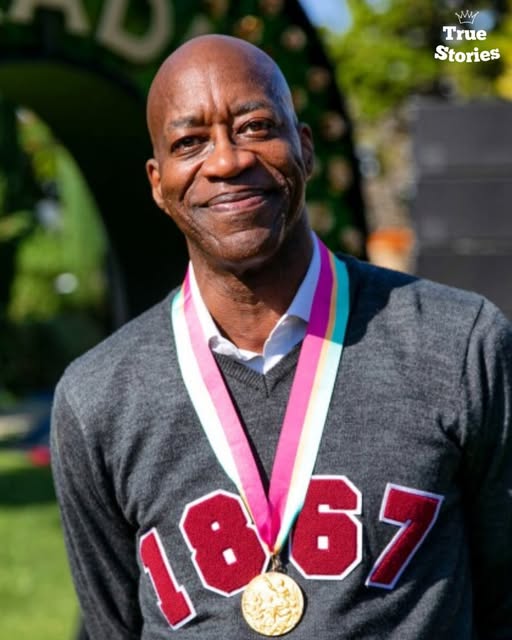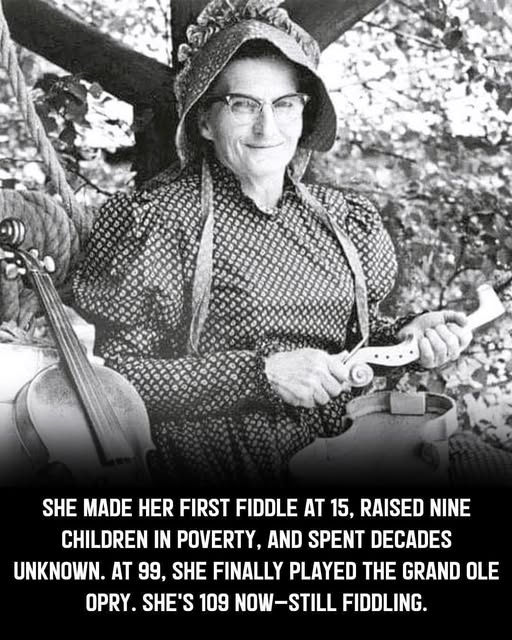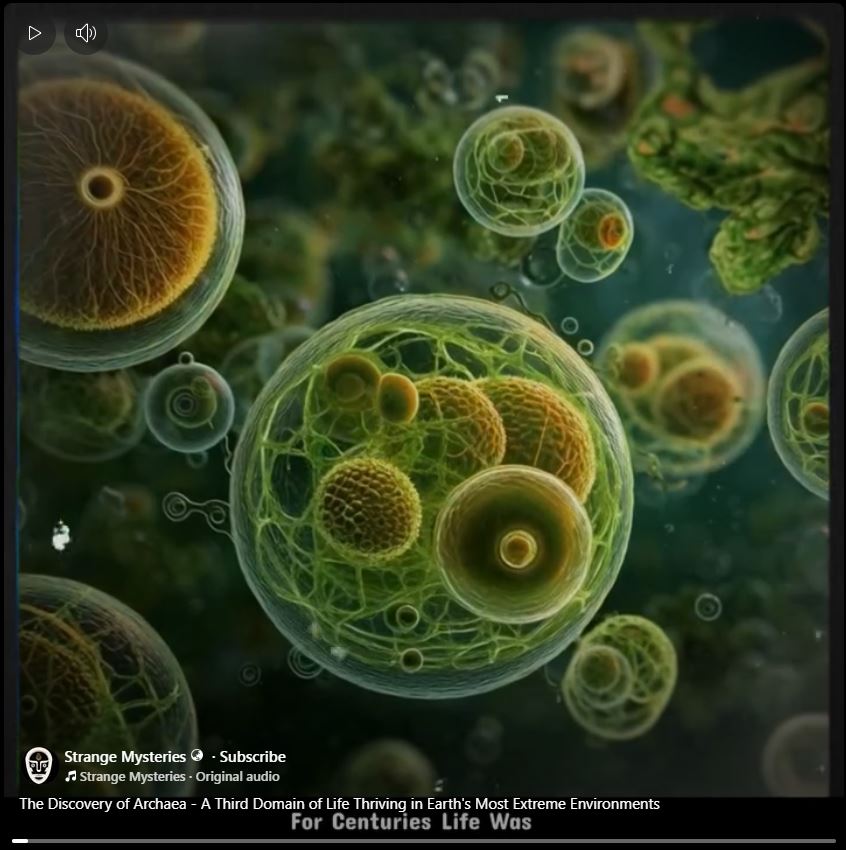
Violet Hensley

In 1931, a fifteen-year-old girl in the Arkansas backwoods told her father she wanted to make a fiddle.
He pointed to his tools and a pile of wood. “There’s what you need. Help yourself.”
Violet Brumley picked up a knife and started whittling.
Her father, George Washington Brumley, had made his first fiddle in 1888 when he was fourteen years old—back when homesteaders built everything themselves because buying wasn’t an option. He’d traded fiddles for wagons, shotguns, milk cows. A fiddle was worth a dollar, maybe, if you sold it for cash.
Violet watched him work, learning which woods sang and which stayed silent. She memorized the curve of the neck, the arch of the top, the precise placement of the sound post. No blueprints. No instruction manual. Just memory and feel.
It took her months to finish that first fiddle. When she drew the bow across the strings, the sound was perfect.
She was hooked.
But life had other plans.
At eighteen, Violet married Adren Hensley. The babies started coming—nine children in all, born while the family scraped by on subsistence farming. They were so poor, Violet later joked, that “if the flies had anything to eat, they’d bring their own food.”
Between 1932 and 1934, she made three more fiddles. Then fiddle number four.
Then nothing. For twenty-seven years.
Nine children don’t raise themselves. Fields don’t plow themselves. There was no time for five-gallon buckets of wood shavings and 250-hour crafting projects when you were trying to keep your family fed.
The fiddles gathered dust. The music stayed quiet.
The family moved to Oregon to pick fruit—strawberries, potatoes, prunes. Migrant work. Survival. In 1959, they heard about cheap land near Yellville, Arkansas—forty acres for $250. They moved back, bought the land, started over.
Violet was in her forties. Her children were growing up. And slowly, quietly, she picked up her knife again.
In 1961, she made fiddle number five.
The break was over. She was a fiddle maker again.
By 1962, at age forty-six, someone convinced her to enter the local Turkey Trot Talent Show in Yellville. She came in second. At the show, she met Jimmy Driftwood, a folk musician who invited her to play at his theater in Mountain View.
That led to the War Eagle Craft Fair.
Which led to Silver Dollar City discovering her in 1967.
The theme park in Branson, Missouri, originally wanted her as a woodcarver. But when they heard her play the fiddles she’d made with her own hands—heard her unique style, her Ozark rhythms, her refusal to play like anyone else—they changed their minds.
They wanted her to fiddle.
And suddenly, after fifty years of obscurity, Violet Hensley became famous.
Not movie-star famous. Folk-legend famous. The kind where Charles Kuralt shows up to interview you for CBS News. Where National Geographic features you in 1970. Where producers from Captain Kangaroo and The Beverly Hillbillies call asking if you’ll appear on their shows.
She traveled to promote Silver Dollar City, appearing on The Art Linkletter Show in 1970, walking around eating ice cream with “Granny” when The Beverly Hillbillies filmed episodes at the park. In 1977, she danced with Mr. Green Jeans on Captain Kangaroo. In 1992, she was on Live with Regis and Kathie Lee.
Through it all, she kept making fiddles. Seventy-four in total, each one taking about 260 hours of work. She used native Ozark woods—buckeye, sassafras, pine, spruce, basswood, cherry, curly maple, bird’s eye maple, quilted maple. She’d cut down the trees herself with a handsaw.
“Someone asked me a long time ago what my secret was of putting the tone into a fiddle,” she said. “The tone just comes in with the wood as best as I can figure.”
Her fiddles became treasures. Collectors paid thousands. Museums displayed them. But Violet kept a few she wouldn’t sell for any price.
She also learned to clog at age sixty-nine—doctor’s orders, after they told her to stop breaking horses and bareback riding. Her signature move became playing the fiddle on top of her head while clogging, her face beaming with pure joy.
For decades, she demonstrated at Silver Dollar City’s festivals. She released three albums with her family—daughters Sandra and Lewonna, husband Adren, son Calvin. The old-time tunes her father had taught her, songs that weren’t widely circulated, preserved through her hands and voice.
In 2004, the Arkansas Arts Council designated her an Arkansas Living Treasure.
But Violet had one dream left.
She’d grown up listening to the Grand Ole Opry on a battery-powered radio when she was nine years old, just after the show debuted in 1925. For ninety years, she’d listened to that program, playing along in her Arkansas cabin, imagining what it would be like to stand on that stage.
It seemed impossible. She was too old, too unknown, too far from Nashville’s spotlight.
Then fiddler Tim Crouch read her autobiography and found mention of her dream. He contacted Opry star Mike Snider.
And on August 6, 2016, at ninety-nine years old, Violet Hensley walked onto the Grand Ole Opry stage.
She wore a purple dress hand-sewn by her daughter Sandra. She carried fiddle number four, the one she’d made when she was seventeen years old.
The audience of 4,400 people rose to their feet before she even played a note.
Snider warned them: “This little lady plays her way.“
Violet launched into “Angelina Baker,” and the band scrambled to keep up with her rapid-fire fiddling. Her unique style—developed in isolation, learned from her father and the old-time fiddlers of the Ozarks—was unlike anything Nashville had heard.
When she finished, the applause was thunderous.
She returned in 2017 for her 100th birthday. Then again in 2018. Three times on the Opry stage, each time leaving audiences with their jaws on the floor.
In 2018, at age 101, she was inducted into the National Fiddler Hall of Fame.
And she kept going.
At 105, she contracted COVID-19. Her symptoms were mild. She recovered.
Today, at 109 years old, Violet Hensley is still alive in Yellville, Arkansas.
Her vision is too poor to make complete fiddles now, but she can still whittle by feel. She still demonstrates her craft. She still plays—fifty-eight years performing at Silver Dollar City and counting.
Her daughters say that while her muscles and words may fail her sometimes, the music never does. “For 109, she probably remembers more than we know, but just can’t say it. She feels it.”
The girl who made her first fiddle in poverty, who spent decades raising children in obscurity, who didn’t become famous until she was in her fifties, who finally achieved her lifelong dream at ninety-nine—she’s still here.
A living bridge to an Ozarks that barely exists anymore. A testament to craft, to patience, to the long game. A reminder that dreams don’t have expiration dates.
Her story started with a father telling his daughter to help herself to his tools. It continues with a 109-year-old woman whose handmade fiddles are museum pieces, whose music has inspired generations, whose life proves that fame delayed isn’t fame denied.
Violet Hensley didn’t become a legend by starting early or burning bright and fast.
She became a legend by never stopping. By making seventy-four fiddles one knife stroke at a time. By playing the music she loved for a century, whether anyone was listening or not.
And when the world finally noticed, she was ready. She’d been practicing for ninety years.
Would you have had the patience to spend decades perfecting a craft in obscurity, knowing your moment might never come?
How a Generation of Women Was Misled About Hormone Therapy
The FDA’s removal of hormone therapy warnings after 23 years validates what many women suspected.
“Was I misled?”
That’s the question I hear most from my patients lately—asked with anger, exhaustion, and the quiet devastation of women who wonder if they lost years of their lives to menopause symptoms they were told were untreatable.
The answer came earlier this month when the U.S. Food and Drug Administration announced it would remove “black box” warnings from hormone therapy products after 23 years. For many women, the reversal is an admission that arrives decades too late.
What Happened in 2002
In July 2002, preliminary data from the Women’s Health Initiative (WHI) were published in JAMA, showing that combined hormone therapy (estrogen and progestin) increased the risk of breast cancer, stroke, and pulmonary embolism. Major media outlets interpreted early signals from the study as definitive danger, and the announcement led to an instant and dramatic decline in the use of hormone therapy.
Women who had been sleeping well for the first time in years suddenly poured their medications into the trash. Pharmacies fielded calls from panicked patients demanding immediate discontinuation. Primary care doctors, most of whom had never been trained deeply in menopause management, told their patients to “stop now and ask questions later.”
Women did stop, and many suffered in silence for the next 20 years.
The FDA’s Historic Reversal
On Nov. 10, the FDA announced that it is initiating the removal of broad “black box” warnings referencing risks of cardiovascular disease, breast cancer, and probable dementia from hormone replacement therapy products for menopause.
When FDA Commissioner Dr. Marty Makary spoke publicly about the shift, he didn’t mince words. He said the media had frightened women away from a potentially life-changing therapy, and he noted the difference between estrogen-only therapy and synthetic combination regimens. He acknowledged, openly, that the “fear machine” had begun long before the scientific data had been fully understood.
He also said something that struck many women deeply: “After 23 years of dogma, the FDA is stopping the fear that has steered women away from this life-saving treatment.”
For many of my patients, that sentence felt like a validation they had waited half a lifetime to hear.
The Devil Is in the Details
The details that matter most sat quietly in the medical literature for years—in the 2002 article and the two follow-up studies published in 2011 and 2020 in JAMA.
The Study Population Was Older
Women recruited in the WHI study were all postmenopausal, aged 50 to 79 years, with an average age of 63—more than a decade past the onset of menopause. Most had not used hormones before, and many had cardiovascular risk factors.
The Hormones Were Synthetic
The adverse results found among older women taking combined conjugated equine estrogen and medroxyprogesterone acetate—both older, synthetic formulations developed in a different era—were generalized to all hormone therapy types and all age groups.
Estrogen-Only Therapy Showed Different Results
The estrogen-only group in the WHI study—women who had hysterectomies and therefore received estrogen without synthetic progestins—had a lower rate of breast cancer.
In the storm of fear that followed, no one wanted to hear nuance.
The Critical Factor
Yet even in the early 2000s, there were physicians who paused, confused because something about the reporting didn’t align with what they were seeing clinically. The hormones used in the WHI study weren’t the bioidentical estradiol and progesterone that many clinicians were already prescribing with good results. More importantly, the women who seemed to benefit most from hormone therapy were those who began it near menopause—not in older age.
Timing is critical. The body responds to estrogen very differently pre-menopause versus a decade post-menopause. After years of low estrogen, the blood vessels lose their flexibility, plaque accumulates, and metabolic changes settle in. The risk-benefit balance is fundamentally different for women who initiate hormone therapy at different ages.
This is what we in medicine now call the “timing hypothesis”—a concept that should have been central to every headline but was lost entirely.
And for two decades, women lived inside that headline and endured the consequences of fear and misinformation.
What Women Lost
The point is not that hormone therapy is perfect or appropriate for everyone. It’s that women were never given the chance to make an informed choice.
Women who begin hormone therapy earlier—ideally within 10 years of menopause—tend to experience improved sleep, reduced anxiety and irritability, and protection against bone loss.
Many report better cognition, improved cardiovascular markers, and enhanced sexual health and relationship well-being. Although spoken about more quietly, perhaps the most profound benefit is the simplest one: the return of themselves.
Takeaways
The new FDA guidelines do not signal a new fad or a sudden reversal. They mark a return to evidence-based medicine—the kind that millions of women should have received all along.
Hormone therapy is not appropriate for every woman, and it is not a cure-all. However, it is a powerful tool, and for the right woman at the right moment, it can restore a quality of life she thought she’d lost forever.
Our job now—as clinicians, as journalists, as a society—is to give women back what fear took from them: clarity, choice, and control.
Everything that follows in this series of columns will build on that mission.
Archaea

Click to view the video: https://www.facebook.com/reel/867470365750627
Advisers plan biggest change yet to childhood vaccine schedule
On December 2nd the Washington Post ran a panicked story headlined, “RFK Jr.’s vaccine advisers plan biggest change yet to childhood schedule.” Kirk Milhoan, newly appointed chair of the CDC’s Vaccine Advisory Committee, ominously announced, “Not enough attention is being paid to risk.”
Dr. Milhoan, who replaced former committee chair Marty Makary, is a pediatric cardiologist, ivermectin proponent, and long-time critic of covid vaccines. You can imagine how much the media likes him. Yesterday, Dr. Milhoan announced that committee members, meeting tomorrow and Friday, will “broadly scrutinize” the entire pediatric vaccine schedule. You could hear a pin drop.
The “discussions on the timing of vaccines and ingredients could signal major changes to how children in the United States are vaccinated,” the Post reported despairingly. Tomorrow, the committee will formally vote on scrapping the hepatitis B vaccine for babies at birth, so long as their mothers test negative for the virus. (Hep B is usually acquired through sex and illegal drug use.)
Furthermore, and even more encouraging, the committee is “looking at what may be causing some of the long-term changes we’re seeing in population data in children, specifically things such as asthma and eczema and other autoimmune diseases,” Milhoan said in an interview Monday.
Then he dropped the hammer. Milhoan said, “What we’re trying to do is figure out if there are factors within vaccines” that could be causing these problems, instantly terrifying every reporter within earshot and sending ice shooting through their veins (at least, the ones not punctured by needle holes).
Currently, and specifically, the committee is considering aluminum, which is added to over a dozen scheduled vaccines, intended to shock recipients’ immune systems into working even better than without aluminum.
“Public health and medical experts have raised alarms that the panel is moving toward recommending that only vaccines without aluminum adjuvants be used,” the Post said. “ Vaccine industry officials said that removing aluminum adjuvants from vaccines would cost billions of dollars and that finding a replacement would take years,” it explained.
The bowtied brigades can feel the walls closing in. Last week, the CDC revised its website to remove the claim that vaccines don’t cause autism. On Friday, the nation’s top vaccine regulator, Dr. Vinay Prasad, announced more stringent approaches to approving vaccines, citing research showing at least ten kids had been killed by the covid shots. Now this.
Government is glacially slow, which is probably a good thing in most cases. By any sane measure, RFK’s team is moving at lightspeed. This is terrific progress.
Source: https://open.substack.com/pub/coffeeandcovid/p/coon-capers-wednesday-december-3?utm_campaign=post
The Calmest Statement

All four engines died at 37,000 feet—and the captain’s announcement became the calmest statement in aviation history.
June 24, 1982. Seven miles above the Indian Ocean.
British Airways Flight 9—a Boeing 747 carrying 263 souls—was cruising peacefully through the night when something impossible began.
First, the crew noticed St. Elmo’s fire. An eerie blue glow crackling across the cockpit windows like electricity dancing on glass.
Then shimmering sparks appeared along the wings, as if the aircraft were trailing fire through darkness.
Captain Eric Moody and his crew had thousands of flying hours between them. They’d seen unusual weather. They’d handled emergencies.
But they’d never seen anything like this.
Then came the alarm they dreaded most.
Engine four had failed.
Before they could process it, engine two quit.
Then engine one.
Then engine three.
In less than 90 seconds, all four engines had stopped.
Complete silence.
At seven miles above the ocean.
A commercial jet losing one engine is manageable. Losing two is a serious emergency. Losing three is catastrophic.
Losing all four?
That’s not supposed to happen. Ever.
Yet here was Captain Moody, flying a 300-ton glider with 263 people aboard, no engines, no power, and no idea why.
The 747 was descending—losing altitude at an alarming rate. Below them: the dark Indian Ocean and the mountainous Indonesian coastline.
They had minutes to figure out what happened and somehow restart the engines.
In the cabin, passengers saw strange sparks outside their windows. Oxygen masks dropped. Thick, acrid smoke filled the air, smelling like sulfur.
People began writing farewell notes.
Then Captain Moody’s voice came over the intercom with what would become one of the most famous announcements in aviation history:
“Ladies and gentlemen, this is your captain speaking. We have a small problem. All four engines have stopped. We are doing our damnedest to get them going again. I trust you are not in too much distress.”
A small problem.
All four engines stopped.
Seven miles in the sky.
That’s not just British understatement. That’s leadership—keeping 263 people calm while facing catastrophe.
In the cockpit: controlled chaos.
Senior First Officer Roger Greaves’ oxygen mask had broken, leaving him gasping in the thin air. Moody immediately descended—trading precious altitude for breathable air.
Flight Engineer Barry Townley-Freeman worked frantically through engine restart procedures while First Officer Barry Fremantle handled communications with Jakarta.
They tried restarting the engines.
Nothing.
Again. Nothing.
Ten attempts. Twelve. Fifteen.
Each failure meant less altitude. Less time. Less sky.
The aircraft descended through 15,000 feet. Then 14,000. Then 13,000.
Below them, somewhere in darkness, were Java’s mountains.
They were running out of options.
At 13,500 feet—with terrain looming—engine four suddenly coughed, sputtered, and roared back to life.
Then engine three.
Then engine one.
Finally, engine two.
All four engines—dead for 13 minutes and 13,000 feet of descent—had somehow restarted.
They had power. They had control.
But they still weren’t safe.
Whatever had killed the engines had also destroyed the windscreen. The windows were opaque, sandblasted to translucence by millions of tiny particles traveling at 500 mph.
Captain Moody could barely see through them.
They had to land this crippled aircraft essentially flying blind.
They used side windows for glimpses. Relied on instruments. Followed radio guidance from Jakarta, trusting voices from the ground.
And somehow, impossibly, Captain Moody brought the battered 747 down safely at Jakarta’s Halim Perdanakusuma Airport.
Not a single person died.
All 263 passengers and crew walked away.
Only after landing did investigators discover the truth.
Mount Galunggung in Java had been erupting. On June 24, it sent a massive ash cloud eight miles high—spreading across flight paths.
Flight 9 had flown directly through it in darkness.
Volcanic ash is pulverized rock—microscopic glass shards suspended in air. Invisible to weather radar. Nearly impossible to see at night.
When jet engines running at over 1,000 degrees ingest it, the ash melts instantly, coating components like molten glass and choking the engines completely.
The engines restarted only because Moody’s descent brought them below the ash cloud, where cooler air allowed the melted glass to solidify and break off.
It was luck as much as skill.
But the skill kept them alive long enough for the luck to matter.
British Airways Flight 9 changed aviation forever.
Before June 24, 1982, volcanic ash was considered a minor nuisance.
After Flight 9:
Global volcanic ash detection systems were established
Airlines receive real-time eruption alerts.
Flight paths are immediately rerouted around ash clouds
The International Airways Volcano Watch was created.
Captain Moody’s experience—and his crew’s quick thinking—saved not just 263 people that night.
It potentially saved thousands in the decades since.
Captain Moody continued flying until retirement. He’s remembered not just for his skill, but for that famous announcement—the calm understatement quoted in aviation training worldwide.
“We have a small problem. All four engines have stopped.”
That’s leadership. Keeping people calm when the world is falling apart. Refusing to give up when giving up would be understandable.
The lesson:
The impossible sometimes happens. Prepare anyway.
Calm leadership saves lives. Panic kills.
Never give up. Moody’s crew tried over 15 times to restart those engines. The 15th attempt worked. If they’d stopped at 14, everyone dies.
June 24, 1982.
All four engines died at 37,000 feet.
The crew had 13 minutes to solve an impossible problem.
They couldn’t see why the engines failed.
They couldn’t see the ash cloud killing them.
They couldn’t see the runway when they landed.
But they could think. They could try. They could refuse to quit.
And 263 people survived because four men in a cockpit refused to accept the impossible.
That’s not just an aviation story.
That’s a reminder that even when all four engines fail—literally and metaphorically—you keep trying. You stay calm. You don’t give up.
Because sometimes, the 15th attempt is the one that works.
Doris Day

Street Smarts

Anna Essinger

The Horse Has Left the Barn
A memo leaked from the FDA over the weekend that admits a point long known among the dissidents. It plainly states that the Covid shot likely killed more children than it saved. So far, with just a minimalist examination, the FDA has found 10 dead kids but cautions there are many more.
This is one of the greatest scandals of our time. Not even the mainstream media could suppress the news, which clearly connects with everyone’s intuitions.
It was left to a new hire at the FDA, Dr. Vinay Prasad, to explain all of this to a nervous legacy bureaucracy. There is much more to come, including the release of all available data on shot safety. The coming weeks are going to be wild.
Brownstone Institute
